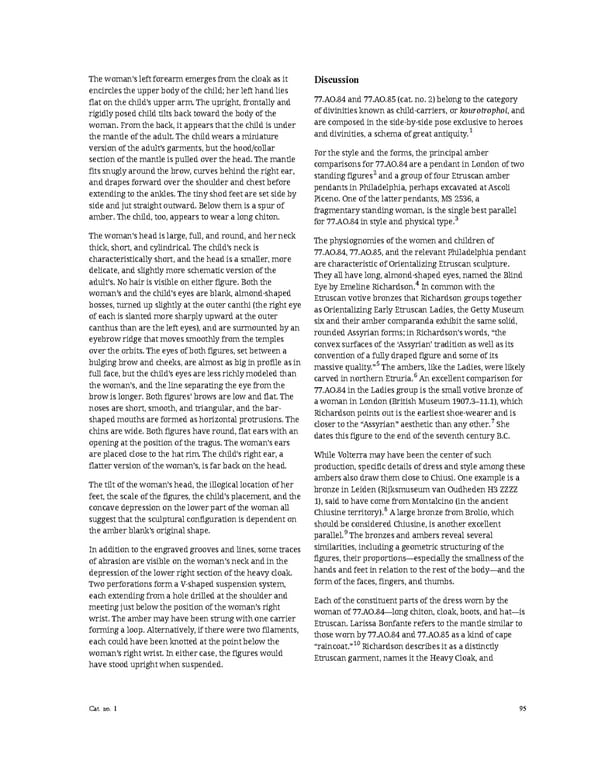The woman’s left forearm emerges from the cloak as it Discussion encircles the upper body of the child; her left hand lies flat on the child’s upper arm. The upright, frontally and 77.AO.84 and 77.AO.85 (cat. no. 2) belong to the category rigidly posed child tilts back toward the body of the of divinities known as child-carriers, or kourotrophoi, and woman. From the back, it appears that the child is under are composed in the side-by-side pose exclusive to heroes the mantle of the adult. The child wears a miniature and divinities, a schema of great antiquity.1 version of the adult’s garments, but the hood/collar For the style and the forms, the principal amber section of the mantle is pulled over the head. The mantle comparisons for 77.AO.84 are a pendant in London of two fits snugly around the brow, curves behind the right ear, standing figures2 and a group of four Etruscan amber and drapes forward over the shoulder and chest before pendants in Philadelphia, perhaps excavated at Ascoli extending to the ankles. The tiny shod feet are set side by Piceno. One of the latter pendants, MS 2536, a side and jut straight outward. Below them is a spur of fragmentary standing woman, is the single best parallel amber. The child, too, appears to wear a long chiton. for 77.AO.84 in style and physical type.3 The woman’s head is large, full, and round, and her neck The physiognomies of the women and children of thick, short, and cylindrical. The child’s neck is 77.AO.84, 77.AO.85, and the relevant Philadelphia pendant characteristically short, and the head is a smaller, more are characteristic of Orientalizing Etruscan sculpture. delicate, and slightly more schematic version of the They all have long, almond-shaped eyes, named the Blind adult’s. No hair is visible on either figure. Both the Eye by Emeline Richardson.4 In common with the woman’s and the child’s eyes are blank, almond-shaped Etruscan votive bronzes that Richardson groups together bosses, turned up slightly at the outer canthi (the right eye as Orientalizing Early Etruscan Ladies, the Getty Museum of each is slanted more sharply upward at the outer six and their amber comparanda exhibit the same solid, canthus than are the left eyes), and are surmounted by an rounded Assyrian forms; in Richardson’s words, “the eyebrow ridge that moves smoothly from the temples convex surfaces of the ‘Assyrian’ tradition as well as its over the orbits. The eyes of both figures, set between a convention of a fully draped figure and some of its bulging brow and cheeks, are almost as big in profile as in massive quality.”5 The ambers, like the Ladies, were likely full face, but the child’s eyes are less richly modeled than carved in northern Etruria.6 An excellent comparison for the woman’s, and the line separating the eye from the 77.AO.84 in the Ladies group is the small votive bronze of brow is longer. Both figures’ brows are low and flat. The a woman in London (British Museum 1907.3–11.1), which noses are short, smooth, and triangular, and the bar- Richardson points out is the earliest shoe-wearer and is shaped mouths are formed as horizontal protrusions. The closer to the “Assyrian” aesthetic than any other.7 She chins are wide. Both figures have round, flat ears with an dates this figure to the end of the seventh century B.C. opening at the position of the tragus. The woman’s ears are placed close to the hat rim. The child’s right ear, a While Volterra may have been the center of such flatter version of the woman’s, is far back on the head. production, specific details of dress and style among these The tilt of the woman’s head, the illogical location of her ambers also draw them close to Chiusi. One example is a feet, the scale of the figures, the child’s placement, and the bronze in Leiden (Rijksmuseum van Oudheden H3 ZZZZ concave depression on the lower part of the woman all 1), said to have come from Montalcino (in the ancient Chiusine territory).8 A large bronze from Brolio, which suggest that the sculptural configuration is dependent on should be considered Chiusine, is another excellent the amber blank’s original shape. parallel.9 The bronzes and ambers reveal several In addition to the engraved grooves and lines, some traces similarities, including a geometric structuring of the of abrasion are visible on the woman’s neck and in the figures, their proportions—especially the smallness of the depression of the lower right section of the heavy cloak. hands and feet in relation to the rest of the body—and the Two perforations form a V-shaped suspension system, form of the faces, fingers, and thumbs. each extending from a hole drilled at the shoulder and Each of the constituent parts of the dress worn by the meeting just below the position of the woman’s right woman of 77.AO.84—long chiton, cloak, boots, and hat—is wrist. The amber may have been strung with one carrier Etruscan. Larissa Bonfante refers to the mantle similar to forming a loop. Alternatively, if there were two filaments, those worn by 77.AO.84 and 77.AO.85 as a kind of cape each could have been knotted at the point below the “raincoat.”10 Richardson describes it as a distinctly woman’s right wrist. In either case, the figures would Etruscan garment, names it the Heavy Cloak, and have stood upright when suspended. Cat. no. 1 95
 Ancient Carved Ambers in the J. Paul Getty Museum Page 104 Page 106
Ancient Carved Ambers in the J. Paul Getty Museum Page 104 Page 106